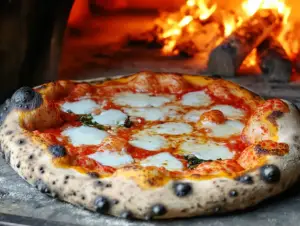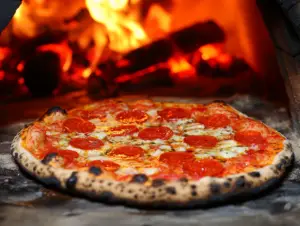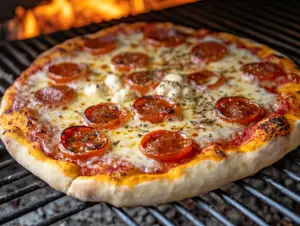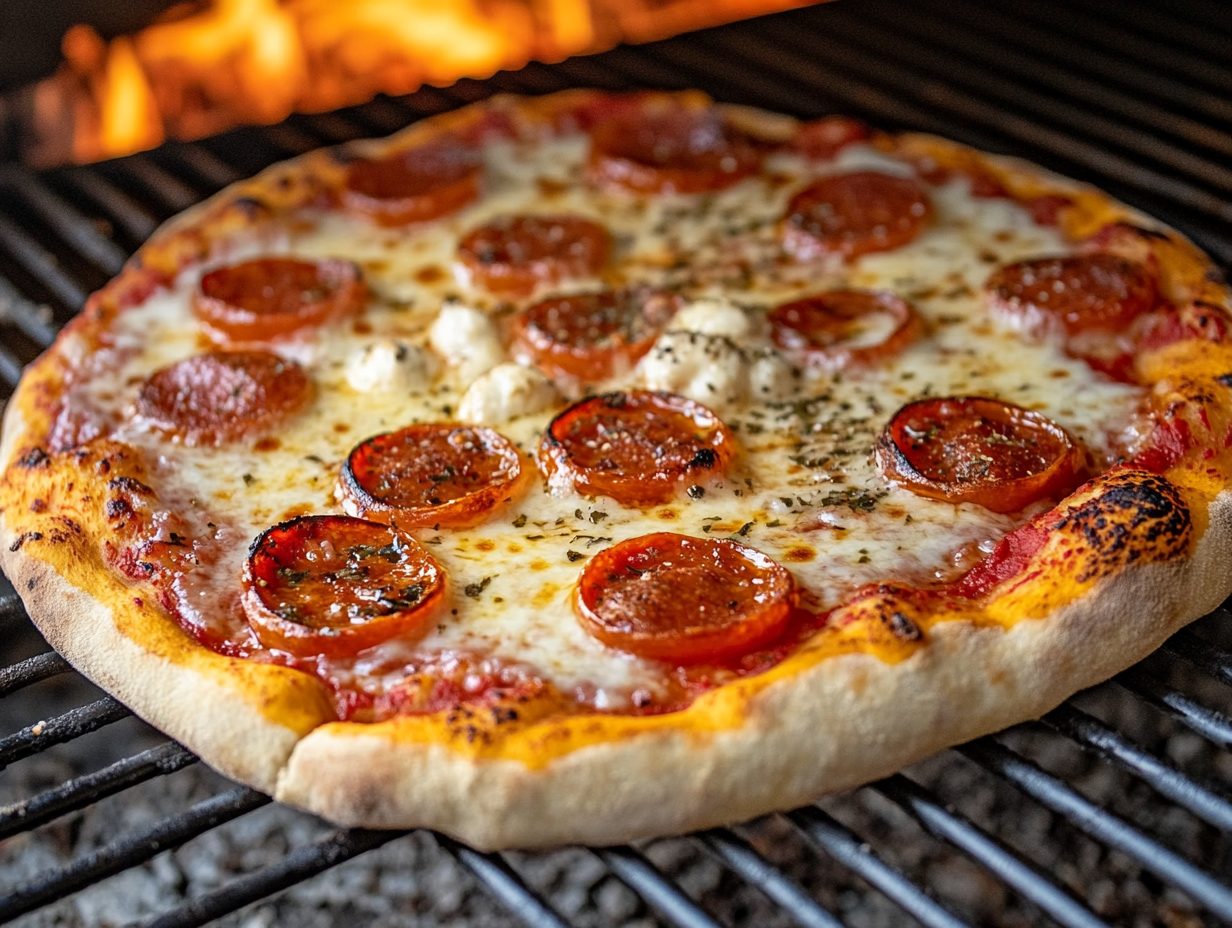Pizza is universally loved, but getting it right at home can be tricky. The oven temperature is a key factor that affects the texture and flavor of your pizza. Whether you’re making a thin New York-style pizza or a thick Chicago deep dish, the right temperature is crucial.
This article will explore the best temperature to cook pizza, considering factors like dough type, toppings, and oven setup. We’ll also cover helpful tools, such as pizza stones and steels, that can improve your results. Plus, we’ll troubleshoot common pizza baking issues.
What Happens When You Cook Pizza at Different Temperatures?
The temperature at which you bake pizza greatly affects the final product. Knowing how heat impacts the dough and toppings will help you choose the best setting for your preferred pizza style.
- Low Temperatures (Below 400°F): Baking pizza at a lower temperature can result in a doughy crust. The dough takes longer to cook, and you might end up with a dense texture. Toppings may dry out before the pizza is fully baked.
- Medium Temperatures (400-450°F): This range is better for thicker pizzas, like deep-dish pizzas. The lower heat allows the thick dough to bake through without burning the outside. However, you may miss the crisp, golden texture of a high-heat pizza.
- High Temperatures (475-550°F): Most homemade pizzas bake best at this range. The high heat creates a light, crispy crust while keeping the center chewy. Toppings cook evenly, and the cheese melts perfectly.
Best Temperature for Pizza in a Home Oven
Most home ovens don’t reach the temperatures of a professional pizza oven, which can go as high as 900°F. However, you can still achieve great results at home by baking pizza between 500°F and 550°F. Experts, such as Andris Lagsdin of Baking Steel, recommend this range for creating a crispy, golden crust and evenly cooked toppings.
In fact, Simply Recipes suggests baking pizza at 500°F for optimal results. The high heat allows the dough to puff up and cook quickly, giving you the perfect crust.
Why High Heat Works
Using high temperatures helps:
- The dough expand quickly, trapping air in the crust
- Cheese melt smoothly without overcooking
- Toppings cook evenly while retaining moisture
- The edges of the crust turn golden and crispy
Use a Pizza Stone or Pizza Steel for Better Results

To make your pizza even better, you can use a pizza stone or pizza steel. Both tools hold and transfer heat to the dough, which improves the texture of the crust.
- Pizza Stone: This tool is made from ceramic or stone and absorbs heat in the oven. When you place the pizza on it, the dough is exposed to consistent heat, which makes the crust crispier.
- Pizza Steel: A pizza steel, made from thick steel, conducts heat more efficiently than a stone. It creates a super-hot surface that bakes the pizza evenly, giving it a crispy, chewy crust.
If you’re unsure which to choose, Serious Eats offers a detailed comparison of pizza stones and steels.
How to Use a Pizza Stone or Steel
- Preheat for 45 minutes: Allow enough time for the stone or steel to absorb the heat.
- Place it on the top rack: This ensures the pizza gets even exposure to the oven’s heat.
- Use a pizza peel: Carefully transfer the pizza onto the hot stone or steel.
Ensure Accurate Temperature with an Oven Thermometer
A common problem when baking pizza is an inaccurate oven temperature. The oven’s built-in thermometer doesn’t always give the most reliable reading. By using a separate oven thermometer, you can ensure that your pizza bakes at the right temperature.
ThermoWorks explains the importance of checking your oven’s accuracy. With an oven thermometer, you’ll get more consistent results and avoid under or overcooking your pizza.
Best Temperatures for Different Pizza Styles
Different pizza types bake best at different temperatures, depending on the dough and thickness.
- Neapolitan Pizza (900°F in Wood-Fired Ovens): This pizza needs extremely high heat to cook in less than two minutes. The result is a soft, chewy crust with slightly charred edges.
- New York Style Pizza (500°F): Known for its thin and foldable slices, New York-style pizza benefits from a high temperature that crisps the crust while keeping the inside soft.
- Chicago Deep Dish Pizza (400-425°F): Because this pizza is thicker, it needs more time at a lower temperature to ensure the dough cooks all the way through without burning the edges.
- Frozen Pizza: Most frozen pizzas recommend baking at 375°F to 425°F. It’s best to follow the manufacturer’s instructions, but always ensure the oven is preheated.
Baking Pizza in Different Oven Types
While conventional ovens work well for most home bakers, other oven types offer different advantages.
- Standard Ovens: Most home bakers use these ovens. To bake a great pizza, make sure you preheat the oven thoroughly. Gas ovens might not get as hot as electric ones, so you may need to bake your pizza a little longer.
- Convection Ovens: Convection ovens circulate hot air, cooking pizza faster and more evenly. You can often reduce the temperature by 25°F and shorten the baking time, making it more energy efficient.
Troubleshooting Common Pizza-Baking Issues
Even when using the right temperature, pizza baking can still present challenges. Here are some common issues you might encounter and solutions to help you fix them.
1. Dough Too Dry
- Issue: The dough turns out dry and tough, lacking the desired chewy texture.
- Cause: This often happens if the oven temperature is too high or the pizza has been baked for too long.
- Solution: Lower the temperature by 25°F or reduce the baking time. You can also brush the crust with a bit of olive oil before baking to keep it moist. Ensure the dough isn’t over-floured during preparation, as this can dry it out as well.
2. Under-cooked Dough with Overcooked Toppings
- Issue: The pizza toppings are browned or overcooked, but the dough in the middle remains raw or undercooked.
- Cause: Uneven heat distribution or placing the pizza too high or low in the oven can cause this problem.
- Solution: Preheat the oven for at least 30 minutes to ensure even heat. Use a pizza stone or steel to bake the pizza evenly. You should also place the pizza in the middle of the oven for balanced heat exposure. If the toppings start to overcook, you can cover the pizza with foil halfway through baking.
3. Soggy Crust
- Issue: The pizza crust becomes soggy, especially in the center, resulting in a limp, wet base.
- Cause: This can happen if the oven temperature is too low, the pizza is overloaded with wet toppings, or if the dough is undercooked.
- Solution: Increase the oven temperature to at least 500°F and ensure the pizza is baked on a preheated pizza stone or steel. Avoid overloading the pizza with watery ingredients like fresh tomatoes or sauce. Draining wet toppings and spreading them evenly can also help prevent a soggy crust.
4. Burnt Crust
- Issue: The edges of the pizza crust become too dark or burnt while the rest of the pizza is still cooking.
- Cause: Baking the pizza at too high of a temperature or leaving it in the oven for too long can lead to burnt edges.
- Solution: Lower the oven temperature by 25°F if the crust burns quickly. You can also cover the edges of the crust with aluminum foil to protect them from burning while the rest of the pizza finishes cooking. Additionally, placing the pizza on a higher rack might help reduce heat exposure to the bottom crust.
5. Pizza Sticks to the Baking Surface
- Issue: The pizza gets stuck to the stone, steel, or pan, making it difficult to remove without tearing the dough.
- Cause: This can happen if the surface isn’t preheated enough or if there’s no flour or cornmeal beneath the dough.
- Solution: Always preheat your pizza stone or steel for at least 45 minutes to ensure a hot surface. Sprinkle a thin layer of flour or cornmeal on the peel before transferring the pizza to the oven. This helps prevent sticking and makes sliding the pizza onto the stone or steel easier.
6. Uneven Browning
- Issue: Some parts of the pizza crust are perfectly golden, while other areas are pale or undercooked.
- Cause: Uneven browning usually occurs due to inconsistent heat or airflow in the oven.
- Solution: Use a convection setting if available, which circulates the air more evenly. You can also rotate the pizza halfway through the baking process to ensure all sides receive the same amount of heat.
7. Cheese Overcooks or Burns
- Issue: The cheese becomes too dark or rubbery, often burning before the rest of the pizza finishes cooking.
- Cause: Using cheese with low moisture content or baking at too high of a temperature can cause this issue.
- Solution: Use high-moisture cheese, such as fresh mozzarella, and distribute it evenly. If your cheese starts to brown too quickly, reduce the oven temperature or consider adding the cheese halfway through the baking process. You can also sprinkle some grated Parmesan or Romano cheese at the end of baking to enhance flavor without risking overcooking.
Quick Troubleshooting Tips

- Always preheat your oven to ensure it’s at the correct temperature before baking.
- Check oven accuracy with an oven thermometer to make sure the actual temperature matches the setting.
- Use a pizza stone or steel for better heat distribution and a crispier crust.
- Avoid overloading with toppings, especially wet ones, as this can cause sogginess or uneven cooking.
- Rotate the pizza midway through cooking to prevent uneven browning.
FAQs
What is the best oven temperature for cooking pizza?
- The best temperature for pizza is between 500°F and 550°F. This range helps create a crisp, golden crust without overcooking the toppings.
Can you cook pizza at 350°F?
- Yes, but it’s not recommended. A pizza baked at 350°F takes much longer and won’t develop the crispy, chewy crust that most people love.
How long do you cook pizza at 500°F?
- Pizza at 500°F usually bakes in 10 to 12 minutes. Check the crust and toppings around the 10-minute mark to ensure everything is evenly cooked.
What is the best temperature for a pizza stone?
- Preheat the pizza stone to 500°F for at least 45 minutes to ensure it holds enough heat to bake the crust properly.
How do you know when pizza is done?
- Pizza is done when the crust is golden and crisp, and the cheese is melted and bubbly. The edges should feel firm, and the bottom should have a slight char.

Conclusion
Cooking pizza at the right temperature is the key to achieving a balance of crispy crust, melted cheese, and well-cooked toppings. Home ovens can still produce excellent results when set between 500°F and 550°F. Using tools like pizza stones, steels, and oven thermometers can make a big difference in improving your homemade pizza.

